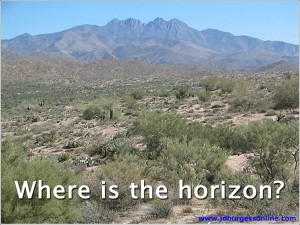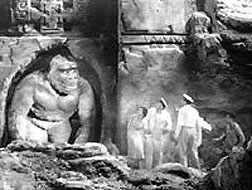-
Romance, Deep Space Nine style
Posted on May 1st, 2009 No commentsRomance between a “changeling” and a “solid” was not going to be easy on Star Trek: Deep Space Nine. For the episode, “Chimera,” Odo and Kira decided to take their relationship to a new level. Because she was a solid, Kira could never “meld” into oneness with the changeling, Odo, so they did the next best thing which was …. what?
At this point the DS9 production team was stumped. What could Odo do?
“Uh, anybody have any ideas?” “How about Odo becoming a cloud and snowing on Kira?” Nope. The women in the production thought it too cold sounding. “Kira could snuggle into Odo as he morphs into a pillow or a blanket.” Hmmm, Odo would have to morph through his goo state to become a pillow or blanket. That didn’t sound warm or cozy. Nothing suggested felt visually beautiful or romantic. So production filming began without this sequence finalized.
-
How to use a Perspective Cube
Posted on April 14th, 2009 No commentsNew visual effects students often have difficulty with the concept and application of the “perspective cube.” A perspective cube is a well constructed box with accurate parallel edges and right angles. Usually it is white with black lines along the edges. Typical construction materials would be white foam core and one inch black paper tape along the edges.
The cube size is somewhat to taste and per your transportation restrictions but it should not be too small. Most appear to be 12″ x 12″ x 12″ or 18″ x 18″ x 18″. I suggest using whole inch measurements and make all side equal as that facilitates quicker set up and ease of reproduction in a Computer Generated Imagery (CGI) environment if needed.
 The perspective cube can be used for multiple reasons. Today we will use the perspective cube to find a horizon line that can’t be seen.
The perspective cube can be used for multiple reasons. Today we will use the perspective cube to find a horizon line that can’t be seen. Suppose you are on location where mountains or vegetation blocks your view of a horizon line and you have no other man-made structures to run perspective lines from to find a vanishing point and horizon line.
-
It began with Kong
Posted on April 1st, 2009 No commentsKing Kong and Son of Kong were the first stop motion visual effects films I was aware of. I was about 8 or 9 yrs old at the time. I have a strong recollection of watching them on our treasured black and white television.
With Son of Kong, I was especially captivated by the images of Skull Island sinking and Carl Denham and others scrambling to the top of the rocks with “Kiko”, the young albino son of Kong. I was moved as Kiko saved the life of Carl Denham at the end. (Yep, Kiko was actually his name per RKO documents of the time.)

Fascinated, I knew something special had unreeled before my eyes but I did not know how it was accomplished. I went and asked my mother how King Kong and Son of Kong were done. She told me they were trained monkeys. Even at my young age, I had seen a number of trained monkeys at zoos and on TV and none of them looked or moved like Kong. I did not know what Kong was but I knew my mother was wrong; Kong was not a trained monkey!
-
A new adventure
Posted on March 29th, 2009 No commentsBlogging is a new adventure for me. With many urgings by my friends and the universe, I can no longer sit on my tush and talk about writing again. Now I have to produce something on a regular basis. Several categories of articles are drawing my interest. Maybe some of you will respond to them as well … or you may give me some suggestions.
Some considerations; film and effects history, my experiences with Cascade Pictures and CPC Associates, Universal Hartland and, of course, David Stipes Productions.
Star Trek stories and behind the scenes on some of my favorite shots will be covered.
Since I am now more involved in education, I may visit that topic as well.
I hope former colleagues will contribute their information and recollections to these topics. It would be nice to document our history and techniques before they are lost. Since I have been teaching, I have seen how much information is slipping away. Many of my students rely on their computer as their only tool to solve visual problems. I want to remind my students of the old tried & true techniques, and maybe keep them alive a while longer.
So, it seems I have several topics to write about. I hope you will return, read along and add to the commentary and conversation.
David


Recent Comments